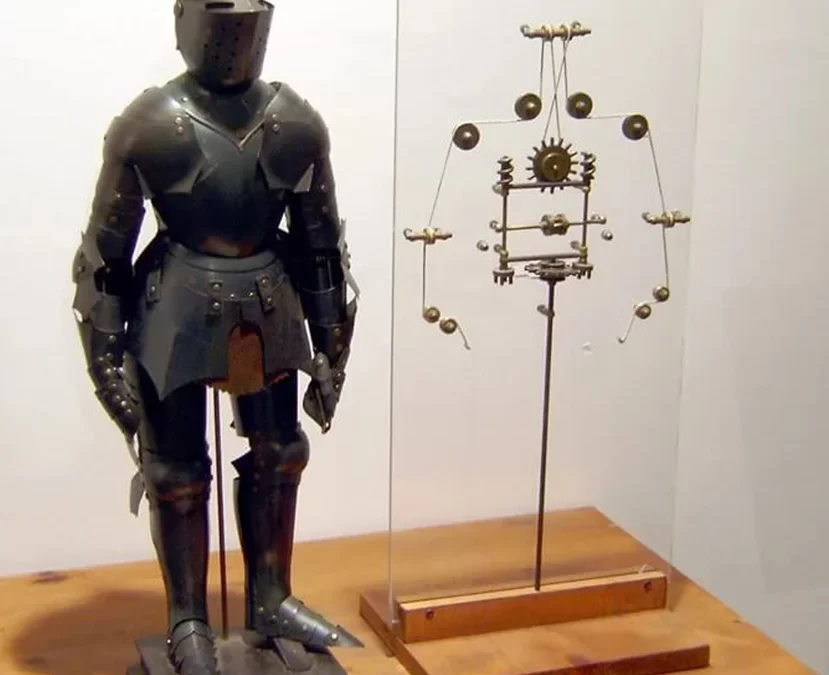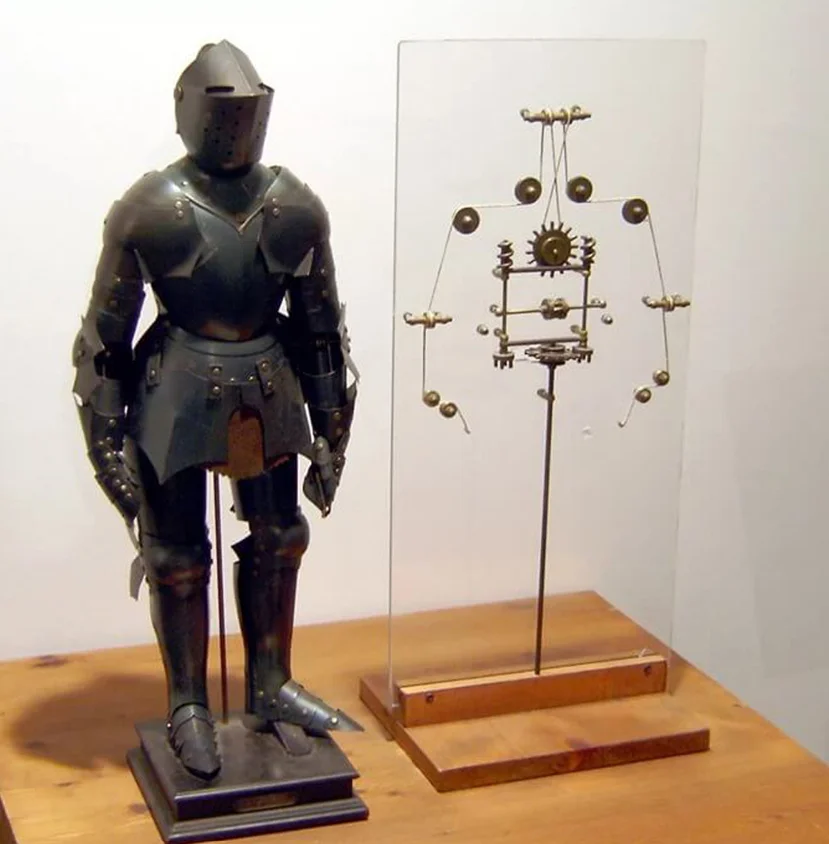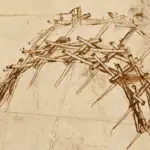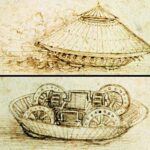Leonardo da Vinci Robotic Knight stood as a fantastic feat of engineering during the Renaissance. This humanoid automaton, designed in the late 15th century, showcased Leonardo’s visionary mind and deep understanding of mechanics.
The Robotic Knight could perform human-like motions, such as moving its arms and sitting down, employing a complex system of gears and pulleys.
For modern enthusiasts, the Robotic Knight remains a fascinating study of early robotics and mechanical design. Its creation involved a German suit of armor filled with an intricate cable and pulley system that allowed it to mimic human movements.
Leonardo’s invention highlights his genius and influences today’s technology in robotics and automation.
Historical Context of Leonardo da Vinci Robotic Knight
The development of the Leonardo da Vinci Robotic Knight showcases the innovative spirit of the Renaissance and the budding exploration of robotic technology during that time.
Groundbreaking inventions and a surge in scientific curiosity marked this era.
Leonardo da Vinci’s Era
Leonardo da Vinci lived during the Italian Renaissance, a period of creativity and new ideas spanning the 14th to the 17th century. This era was characterized by significant advancements in art, science, and technology.
Da Vinci was a central figure in this movement, known for his vast range of interests and talents.
His work went beyond painting; he delved into anatomy, engineering, and physics.
During this time, da Vinci explored various mechanical concepts, including the Leonardo da Vinci Robot Knight, a humanoid machine designed around 1495. This design demonstrated his understanding of mechanics and motion and reflected the era’s fascination with machines and automation.
Advent of Renaissance Robotics
The Renaissance laid the groundwork for modern technology, with figures like Leonardo leading the way.
Da Vinci’s interest in mechanics and engineering led to the creation of the Robotic Knight. He designed this automaton using a complex system of gears, pulleys, and cables—an innovation for its time.
This mechanical knight could stand, sit, and raise its visor, capturing the imagination of future inventors.
Although it is uncertain whether the knight was ever built, the designs highlight the era’s adventurous spirit in exploring new technologies.
Da Vinci’s work in robotics was just one aspect of his diverse inventions, which included the self-propelled cart and diving suit.
The Robotic Knight
The Robotic Knight, created by Leonardo da Vinci, is one of his most fascinating inventions. It blends art with mechanical ingenuity and showcases Leonardo’s ability to think ahead of his time.
Design and Inspiration
Leonardo da Vinci robotic knight was a remarkable feat of design. Constructed in the late 15th century, this automaton was housed in a German-style armor suit. The design involved a series of complex gears, pulleys, and cables.
These components allowed the knight to perform various movements, such as sitting, standing, and even moving its arms.
The inspiration for the robot knight came from Leonardo’s deep interest in the human body and mechanics.
His studies in anatomy greatly influenced the robot’s motion mechanics, simulating human actions with impressive accuracy.
This creation was not merely a display piece; it represented Leonardo’s vision of what machines could achieve, mirroring the human form and movement.
Leonardo’s ability to interlace art with engineering laid a foundation for future developments in robotics.
Mechanical Engineering Feats
The mechanical engineering behind Leonardo da Vinci robotic knight was truly ahead of its time.
Using basic principles of physics and mechanics, Leonardo created a humanoid automaton that could mimic human gestures.
The internal structure comprised sophisticated gear systems, allowing a range of motion not seen before in mechanical creations.
This invention highlighted Leonardo’s genius in combining artistic vision with technical prowess. The engineering principles seen in the knight influenced later developments in automation and robotics.
His work on this device exemplifies his trailblazing ideas, paving the way for future engineers and inventors.
Functionality and Characteristics
Leonardo da Vinci robotic knight was a groundbreaking invention that showcased his genius in mechanical design and automation. Thanks to its sophisticated system of pulleys and gears, the robotic knight could perform human-like motions.
Simulated Anatomy
Leonardo da Vinci robot knight was engineered to mimic the functions of a human body. It could sit, stand, move its arms, and even tilt its head.
This creation was largely possible due to Leonardo’s innovative use of anatomy, which allowed the knight to mimic human motions. The internal structure included complex systems of cables and pulleys resembling muscles and tendons.
His meticulous study of human anatomy heavily influenced his design. Each joint and limb of the da Vinci robot knight was carefully crafted to allow fluid movement.
Through these designs, Leonardo demonstrated his vision of human-machine interaction, blending mechanical engineering with biological insight to form a mechanical knight that remains a topic of fascination.
Innovative Mechanisms
Leonardo’s robot showed innovation through its mechanisms, which used gears and pulleys to bring the knight to life.
This mechanical setup powered the knight’s arms in a lateral embrace, simulating human motion. Leonardo da Vinci’s mechanical genius is evident in his ability to incorporate flexible neck movement into the knight’s design.
By integrating these components, Leonardo da Vinci robots were far ahead of their time, paving the way for later advancements in robotics.
The robotic knight was not merely a mechanical marvel but also an embodiment of da Vinci’s forward-thinking approach, showcasing how art, science, and technology could merge.
Cultural and Historical Impact
The Leonardo da Vinci Robotic Knight is a notable creation that has significantly influenced the development of robotics and left a lasting mark on popular culture. It demonstrates Leonardo’s foresight in mechanical engineering.
Influence on Modern Robotics
Leonardo da Vinci’s mechanical knight, designed in 1495, represents a pivotal moment in the history of robotics. This early robot knight featured a complex system of gears and pulleys, allowing it to mimic human movements.
It has inspired contemporary engineers and roboticists, offering a glimpse into automated machines long before the technology was feasible.
This invention highlights how Renaissance innovations laid the groundwork for future developments.
It is considered a precursor to modern robotic designs, embodying principles that continue to influence today’s robotic engineering.
Inventors often return to da Vinci’s work for inspiration, examining the balance of form and function he achieved.
The combination of creativity and technology in the robotic knight exemplifies the timelessness of Leonardo da Vinci’s vision of robotics.
Representation in Popular Culture
The da Vinci robotic knight is featured prominently in various forms of media, and its story captivates audiences across generations.
This Leonardo da Vinci robot has appeared in documentaries, books, and exhibitions, educating the public about its unique design and functionality.
It brings magic to historical explorations of da Vinci’s life, merging the fantastical with the factual.
In popular culture, the robot knight Leonardo da Vinci is an emblem of the Renaissance period.
It showcases the intersection of art and science that defines Leonardo’s legacy.
By influencing storytellers and artists, the knight perpetuates Leonardo da Vinci’s revolutionary ideas, underscoring his lasting impact on technology and culture.
Preservation and Study
The preservation of Leonardo da Vinci robotic knight involves physical restoration efforts and various exhibitions showcasing this remarkable invention. These activities contribute to maintaining the knight’s historical significance and advancing its understanding and appreciation among audiences.
Restoration Efforts
The study and restoration of Leonardo da Vinci robotic knight require meticulous attention to detail.
Efforts focus on preserving mechanical integrity and historical accuracy.
Historians and engineers collaborate to ensure the reconstruction aligns with da Vinci’s original sketches. The Codex Madrid, for example, captures essential insights into the knight’s mechanism.
Preservation involves analyzing materials and techniques from the Renaissance to maintain authenticity.
Teams use non-invasive methods to study and restore the gears and pulley systems without damaging them. These careful routines help maintain the knight’s condition for future generations.
Exhibitions and Displays
Exhibitions are crucial in showcasing Leonardo da Vinci’s robotic knight to the public.
Museums worldwide, such as the Leonardo3 Museum, offer visitors opportunities to explore the intricacies of the knight’s design.
These displays often use interactive models and digital reconstructions, allowing visitors to experience the knight’s functionality visually and physically.
Special exhibitions sometimes feature the knight alongside da Vinci’s other innovations, such as the self-propelled cart and the armored car.
Such presentations highlight Leonardo’s ingenuity and emphasize how advanced his thinking was for his time. These events help enhance public interest and deepen appreciation for Leonardo’s inventions.
Closing Remarks
Leonardo da Vinci Robotic Knight is a testament to his incredible vision and inventive spirit. This creation, designed in the late 15th century, highlights da Vinci’s deep understanding of mechanics and anatomy.
His work paved the way for future developments in robotics.
The Robotic Knight was envisioned to move with the help of gears and pulleys, depicting Leonardo’s innovative mastery over mechanical devices. This invention displayed his foresight, anticipating advancements that would captivate minds centuries later.
Leonardo was well ahead of his time in his fascination with human and machine movement. His designs merged artistry with engineering, emphasizing the importance of interdisciplinary thinking.
Key Takeaways:
- Leonardo da Vinci’s Robotic Knight is a prime example of early robotics.
- His designs have inspired many modern-day engineers and artists.
Leonardo’s contributions to mechanical inventions continue influencing and inspiring, showcasing how art and engineering can interconnect seamlessly.
Frequently Asked Questions
Leonardo da Vinci pioneered in many fields, including robotics and engineering. His work laid the foundation for several inventions that inspired future technologies.
Did Leonardo da Vinci invent the robotic knight?
Yes, Leonardo da Vinci designed the Robotic Knight. It was a suit of armor filled with gears and pulleys. This mechanical figure could move its arms, sit, and even lift its visor, making it one of the earliest concepts of a robot.
Did Leonardo da Vinci make a robot lion?
Leonardo also designed a mechanical lion. This marvel could reportedly walk and open its chest to reveal a bouquet of lilies, showcasing his inventive genius and love for automata.
How accurate is the Da Vinci robot?
The da Vinci Surgical System‘s accuracy is generally reported to be within 1.02 mm, making it an exact tool for various surgical procedures.
This robotic system enhances the surgeon’s ability to perform complex, minimally invasive surgeries by reducing hand tremors and improving dexterity, ultimately leading to better surgical outcomes.
What war machines did Leonardo da Vinci invent?
Leonardo da Vinci designed several war machines, including a tank and a large crossbow. His innovative and intricate designs show his skill as an engineer and inventor.
What was Leonardo da Vinci’s most significant invention?
Identifying Leonardo’s most significant invention is challenging, as he contributed to many areas. His designs, like the flying machine and the self-propelled cart, were groundbreaking, and each showcased his diverse talents.
Did Leonardo da Vinci have a wife?
No, Leonardo da Vinci did not marry. He dedicated his life to art and science, spending much time on various projects and studies.
Did da Vinci invent the blender?
No, Leonardo da Vinci did not invent the blender. This household appliance was developed much later, though he did design many other inventive devices.
Did da Vinci invent the diving suit?
Leonardo designed a diving suit intended for underwater exploration. It included a breathing tube and bag, foreshadowing modern scuba gear.
Who was the first person to invent a robot?
Leonardo da Vinci is often credited with creating one of the first robotic concepts, his Robotic Knight design, an early exploration into mechanical automation.
Did da Vinci design a tank?
Yes, Leonardo designed an early version of a tank. The design included a covered vehicle with weaponry, a precursor to modern armored vehicles. His vision was centuries ahead of its time.


 I’m Leonardo Bianchi, the mind behind Leonardo da Vinci's Inventions. Thanks for visiting.
I’m Leonardo Bianchi, the mind behind Leonardo da Vinci's Inventions. Thanks for visiting. 


